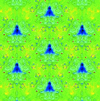issue contents
October 2019 issue

Cover illustration: A tolerance factor of the garnet structure is provided to predict phase stability and investigate crystal chemistry. It is expected to serve as a useful structural descriptor for the garnet structure. Thus, the crystal chemistry, phase stability and material properties of garnet-type compounds could be investigated to a deeper level. Chemists and materials researchers could further employ the tolerance factor in machine learning and high-throughput screening applications to discover new compounds with the garnet structure. See Song, Zhou & Liu [Acta Cryst. (2019), C75, 1353-1358].
research papers




























 journal menu
journal menu































